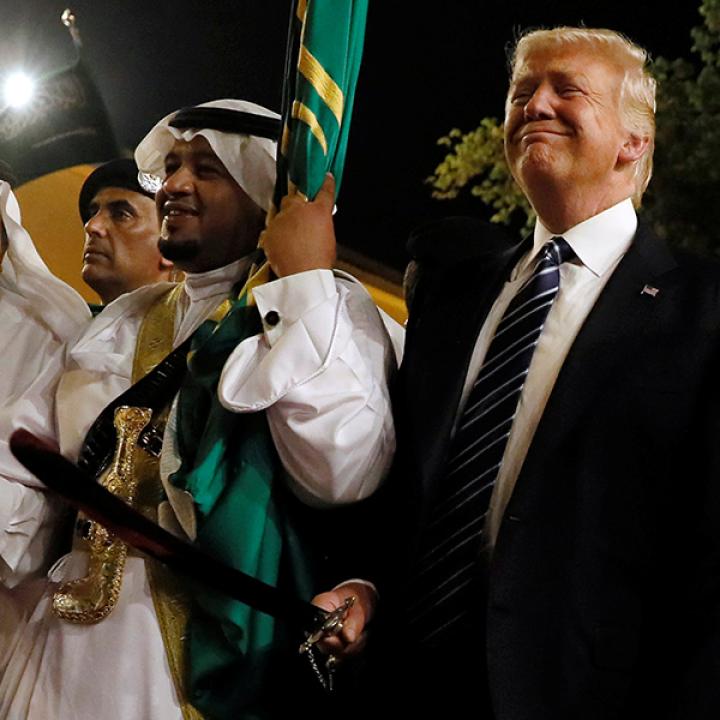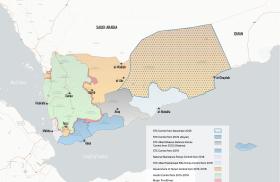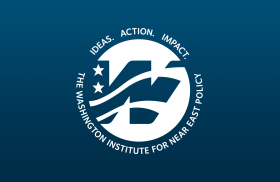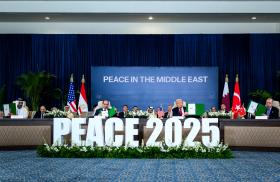
- Policy Analysis
- Articles & Op-Eds
Trump’s Pivot to the Gulf
Also published in Caravan

The Gulf might be “the New Middle East,” but Washington should not forget that problems in “the Old Middle East” still set much of the regional agenda, raising the need for more consistent American engagement.
President Trump’s first official scheduled trip abroad was all about investment. According to the White House, the president secured a total of $2 trillion in deals during his May 2025 visits to Riyadh, Doha, and Abu Dhabi. No doubt, some of the agreements—especially those related to the export of advanced microchip technology—were controversial. In terms of deliverables, however, the Gulf tour was a resounding success. But the significance of the trip extended well beyond economic dividends for the US.
At the risk of ascribing some sort of grand strategy to the Trump Administration, the trip represents a dramatic departure from Washington’s traditional Middle East focus on the Levant toward the Arabian Gulf. While the energy-rich Gulf was always the economic epicenter of the region for the US, for nearly half a century Washington has largely concentrated its diplomatic and political capital on the Fertile Crescent. The increased concentration on the Gulf has benefits, and potential risks for US interests in the region.
This policy reorientation—consistent with the approach during his first term—clearly reflects President Trump’s transactionalist bent, his unabashed preference for states that can provide something to the US over important and helpful but dependent beneficiary debtor states. At the same time, the shift in the center of gravity mirrors the rising influence and economic and diplomatic importance of Saudi Arabia and the United Arab Emirates and the diminished stature of Egypt. The increased emphasis on the Gulf also echoes Trump’s shift away from Egypt and Jordan and towards Israel’s partners in the Abraham Accords.
Another factor underpinning the US regional pivot appears to be Trump’s appreciation for the Gulf’s “transformation” project. The president discussed the changes at length during his May 13 speech in Riyadh, where he described “a new generation of leaders...forging a future where the Middle East is defined by commerce, not chaos; where it exports technology, not terrorism; and where the people of different nations, religions, and creeds are building cities together, not bombing each other out of existence.”
Importantly for Trump, who is a proud nativist, the changes were concordant with local customs. “Peace, prosperity and progress,” he noted, “ultimately came not from a radical rejection of your heritage, but rather from embracing your national traditions.” For Trump, the Gulf represents a model for the entire region of how to build societies with flourishing economies, higher standards of living, and more freedom. And the birth of this new, modern Middle East, he observed approvingly, was not the result of US intervention, but had “been brought by the people of the region themselves.”
To be sure, Trump is right about the remarkable progress made in the Gulf. The region today is among the most dynamic in the world in terms of technological advancement, economic diversification, and social progress. Likewise, in recent years, Gulf states have eclipsed Egypt and Jordan as the principal destination for US diplomatic initiatives and mediation efforts, whether related to Hamas, Iran, the Houthis, or Ukraine. To wit, Egypt’s March 2025 proposal to reconstruct Gaza—which lacked suggestions on governance and security—died on the vine due to Saudi and Emirati disinterest.
It bears mention, of course, that while Saudi, UAE, Qatar, Bahrain, and Oman deserve credit for their accomplishments, these states do not represent a viable development model for most of the region. The undeniable progress in these states was in large part possible because of large reserves of oil and natural gas, and substantial associated sovereign wealth funds.
While the appeal of the Gulf to Trump is understandable, a precipitous swing could have implications for US interests in the region. The Administration’s principal objectives in the region are the promotion of peace and stability, denying Iran a nuclear weapon, constraining Tehran’s regional proxies, enlarging the Abraham Accords, and expanding US commercial opportunities. Many of these goals are necessarily focused in the Gulf—but they are also connected to the Arab countries of the Levant and its vicinity. Indeed, as the Gaza war demonstrated, instability in the Levant still has the potential to destabilize the whole region and impact Gulf states’ own objectives.
The US shift to the Gulf has affected Washington’s other regional partners unevenly. Despite concerns that the Administration’s rescission bill would curtail funding to Jordan and Egypt, both states emerged from the appropriations process intact. In 2026, Jordan and Egypt will receive roughly the same amount of US military and budget support that they did in 2025, $1.65 billion and $1.45 billion respectively.
Other important US partner states were not as fortunate. Lebanon, which is in the sixth year of a catastrophic economic crisis and where the armed forces are currently in the initial stages of disarming the Iran-backed proxy terrorist organization Hezbollah, could see US military and economic assistance zeroed-out from $239 million last year. Meanwhile Iraq, which has its own Iran-backed militia problem and the remnants of the Islamic State to contend with, also appears to have lost out on US military funding. With the possible exception of the Kurdish Peshmerga Forces, US assistance seems poised to wind down in 2026.
Baghdad has its own complicated relationship with local Iranian proxy militias. It also has significant oil reserves and financial resources, which it squanders on a statist economy that defies reform. Lebanon is another story. At the insistence of Washington, Beirut appears poised to task the Lebanese Armed Forces with confronting Hezbollah. It’s a big undertaking for an under-resourced force. At present, Qatar is provisioning the force with fuel and augmenting LAF salaries, which have been decimated by a 98% currency devaluation. The absence of US funds to support this Washington-driven mission is counterproductive.
A bigger challenge in the Levant, however, is the absence of continuous, robust American diplomacy. Many Gulf state leaders seem content with periodic phone calls with Trump and the occasional visit of the president’s most trusted advisor Steve Witkoff. Trump has also met with Jordan’s King Abdullah and spoken with him—and Egyptian President Abdel Fattah al Sisi—on the phone. While other presidential envoys have visited Lebanon and Egypt, and Secretary of State Marco Rubio has met and spoken with senior officials in the Levant, almost eight months into the Administration, there doesn’t appear to be other ongoing high-level USG contact with the region on important but less-pressing matters.
State Department layoffs and a dearth of confirmed and appointed officials in the front office of State’s Near East Affairs Bureau have limited the department’s reach. Perhaps the centralization of Middle East policy in the White House is intentional. The problem is that Special Envoys deal with discrete issues, while senior State Department officials handle the broad spectrum of these bilateral relationships, matters that don’t necessarily rate presidential consideration.
Syria is getting a lot of attention from a Trump confidant, Special Envoy Tom Barrack. Other states in the Levant, less so. Jordan is reeling from two years of war in Gaza, and facing significant economic challenges. Egypt is punting on IMF-mandated economic reforms, despite its financial morass. Meanwhile, Lebanon is balking at its promised economic reforms, required to extricate the state from its own crisis. For its part, Iraq is moving to legally recognize Iranian-backed militias, creating its very own version of the Islamic Revolutionary Guard Corps. Iranian Supreme National Security Council Secretary Ali Larijani visited Iraq in August; senior US diplomats and civilian officials have yet to visit Baghdad during the Trump Administration.
These endemic problems will get worse without more consistent US engagement. As CENTCOM Commander Gen. Erik Kurilla—who, unlike senior US Washington-based diplomats, is a frequent visitor to the region—recently said, “There is no way you can fully grasp the complexities, challenges, and opportunities of the Middle East...without physically visiting the region.”
The Trump Administration’s pivot to the Gulf may advance US interests in the region. But in the process, it will be important to continue to pay attention to the Levant. The Arabian Gulf might be “the New Middle East,” but problems in “the Old Middle East” may still set the regional agenda. To constrain Iran’s proxies, staff an Arab contingent for a day-after plan in Gaza, and/or enlarge the Abraham Accords, Washington will need to work with its more challenged partner states in the Levant.
David Schenker is the Taube Senior Fellow at The Washington Institute and director of its Rubin Program on Arab Politics. This article was originally published on the Hoover Institution website.



